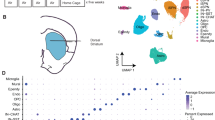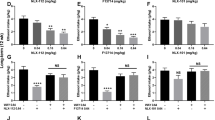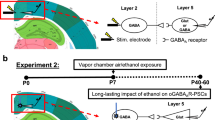Abstract
Alcoholism is a pervasive disorder perpetuated in part to relieve negative mood states like anxiety experienced during alcohol withdrawal. Emerging evidence demonstrates a role for the serotonin-rich dorsal raphe (DR) in anxiety following ethanol withdrawal. The current study examined the effects of chronic ethanol vapor exposure on the DR using slice electrophysiology in male DBA2/J mice. We found that chronic ethanol exposure resulted in deficits in social approach indicative of increased anxiety-like behavior at both 24 h and 7 days post-ethanol exposure. At 24 h post-ethanol exposure, we observed increased excitability and decreased spontaneous inhibitory transmission (inhibitory postsynaptic currents, IPSCs) in the DR. At 7 days post-ethanol exposure, we observed increased spontaneous and miniature excitatory transmission (excitatory postsynaptic currents, EPSCs). Because acute ethanol alters GABA transmission in other brain regions, we assessed the effects of ex vivo ethanol (50 mM) on miniature IPSCs (mIPSCs) in the DR 24-h post-ethanol exposure. Bath application of ethanol enhanced the amplitude of mIPSCs in cells from ethanol-naive and chronic intermittent ethanol-exposed (CIE) mice, but significantly enhanced the frequency of mIPSCs only in cells from CIE mice, suggesting that DR neurons are more sensitive to the inhibitory effects of acute ethanol following CIE. On the basis of these findings, we hypothesize that net excitation of DR neurons following chronic ethanol exposure contributes to enhanced anxiety during ethanol withdrawal, and that increased sensitivity of DR neurons to subsequent ethanol exposure may mediate acute ethanol’s ability to relieve anxiety during ethanol withdrawal.
Similar content being viewed by others

Log in or create a free account to read this content
Gain free access to this article, as well as selected content from this journal and more on nature.com
or
References
Arango V, Underwood MD, Boldrini M, Tamir H, Kassir SA, Hsiung S et al (2001). Serotonin 1A receptors, serotonin transporter binding and serotonin transporter mRNA expression in the brainstem of depressed suicide victims. Neuropsychopharmacology 25: 892–903.
Beck O, Borg S, Sedvall G (1983). Tryptophan levels in human cerebrospinal acute and chronic ethanol consumption fluid after. DrugAlcohol Depend 12: 217–222.
Becker HC, Lopez MF (2004). Increased ethanol drinking after repeated chronic ethanol exposure and withdrawal experience in c57bl/6 mice. Alcohol Clin Exp Res 28: 1829–1838.
Booth B, Russell DW, Yates WR, Laughlin PR, Brown K, Reed D (1992). Social support and depression in men during alcoholism treatment. J Subst Abuse 4: 57–67.
Buckner JD, Timpano KR, Zvolensky MJ, Sachs-Ericsson N, Schmidt NB (2008). Implications of comorbid alcohol dependence among individuals with social anxiety disorder. Depress Anxiety 25: 1028–1037.
Carneiro AMD, Airey DC, Thompson B, Zhu CB, Lu L, Chesler EJ et al (2009). Functional coding variation in recombinant inbred mouse lines reveals multiple serotonin transporter-associated phenotypes. Proc Natl Acad Sci USA 106: 2047–2052.
Challis C, Boulden J, Veerakumar A, Espallergues J, Vassoler FM, Pierce RC et al (2013). Raphe GABAergic neurons mediate the acquisition of avoidance after social defeat. J Neurosci 33: 13978–13988 13988a.
Charney DA, Zikos E, Gill KJ (2010). Early recovery from alcohol dependence : factors that promote or impede abstinence. J Subst Abuse Treat 38: 42–50.
Cox BR, Olney JJ, Lowery-Gionta EG, Sprow GM, Rinker JA, Navarro M et al (2013). Repeated cycles of binge-like ethanol (EtOH)-drinking in male C57BL/6J mice augments subsequent voluntary EtOH intake but not other dependence-like phenotypes. Alcohol Clin Exp Res 37: 1688–1695.
Dubois DW, Perlegas A, Floyd DW, Weiner JL, McCool BA (2006). Distinct functional characteristics of the lateral/basolateral amygdala GABAergic system in C57BL/6J and DBA/2J mice. J Pharmacol Exp Ther 318: 629–640.
Dundon W, Lynch KG, Pettinati HM, Lipkin C (2004). Treatment Outcomes in Type A and B Alcohol Dependence 6 Months After Serotonergic Pharmacotherapy. Alcohol Clin Exp Res 28: 1065–1073.
Dutton CE, Adams T, Bujarski S, Badour CL, Feldner MT (2014). Posttraumatic stress disorder and alcohol dependence: individual and combined associations with social network problems. J Anxiety Disord 28: 67–74.
Fleming RL, Wilson Wa, Swartzwelder HS (2007). Magnitude and ethanol sensitivity of tonic GABAA receptor-mediated inhibition in dentate gyrus changes from adolescence to adulthood. J Neurophysiol 97: 3806–3811.
Fox HC, Anderson GM, Tuit K, Hansen J, Kimmerling A, Siedlarz KM et al (2012). Prazosin effects on stress- and cue-induced craving and stress response in alcohol-dependent individuals: preliminary findings. Alcohol Clin Exp Res 36: 351–360.
Fu W, Le Maître E, Fabre V, Bernard JF, David Xu ZQ, Hökfelt T (2010). Chemical neuroanatomy of the dorsal raphe nucleus and adjacent structures of the mouse brain. J Comp Neurol 518: 3464–3494.
Glöckner-Rist A, Lémenager T, Mann K (2013). Reward and relief craving tendencies in patients with alcohol use disorders: results from the PREDICT study. Addict Behav 38: 1532–1540.
Grahn RE, Watkins LR, Maier SF (2000). Impaired escape performance and enhanced conditioned fear in rats following exposure to an uncontrollable stressor are mediated by glutamate and nitric oxide in the dorsal raphe nucleus. Behav Brain Res 112: 33–41.
Hale MW, Shekhar A, Lowry Ca (2012). Stress-related serotonergic systems: implications for symptomatology of anxiety and affective disorders. Cell Mol Neurobiol 32: 695–708.
Hamilton KR, Ansell EB, Reynolds B, Potenza MN, Sinha R (2013). Self-reported impulsivity, but not behavioral choice or response impulsivity, partially mediates the effect of stress on drinking behavior. Stress 16: 3–15.
Hasin DS, Stinson FS, Ogburn E, Grant BF (2007). Prevalence, correlates, disability, and comorbidity of DSM-IV alcohol abuse and dependence in the United States: results from the national epidemiologic survey on alcohol and related conditions. Arch Gen Psychiatry 64: 830–842.
Huang MM, Overstreet DH, Knapp DJ, Angel R, Wills TA, Navarro M et al (2010). Corticotropin-releasing factor (CRF) sensitization of ethanol withdrawal-induced anxiety-like behavior is brain site specific and mediated by CRF-1 receptors: Relation to stress-induced sensitization. J Pharmacol Exp Ther 332: 298–307.
Hwa LS, Debold JF, Miczek Ka (2013). Alcohol in excess: CRF1 receptors in the rat and mouse VTA and DRN. Psychopharmacology 225: 313–327.
Kelly JF, Hoeppner B, Stout RL, Pagano M (2012). Determining the relative importance of the mechanisms of behavior change within alcoholics anonymous: a multiple mediator analysis. Addiction 107: 289–299.
Kirby LG, Pan YZ, Freeman-Daniels E, Rani S, Nunan JD, Akanwa A et al (2007). Cellular effects of swim stress in the dorsal raphe nucleus. Psychoneuroendocrinology 32: 712–723.
Knapp DJ, Overstreet DH, Huang M, Wills TA, Whitman BA, Angel RA et al (2011). Effects of a stressor and corticotrophin releasing factor on ethanol deprivation-induced ethanol intake and anxiety-like behavior in alcohol-preferring P rats. Psychopharmacology 218: 179–189.
Knapp DJ, Overstreet DH, Moy SS, Breese GR (2004). SB242084, flumazenil, and CRA1000 block ethanol withdrawal-induced anxiety in rats. Alcohol 32: 101–111.
Knapp DJ, Overstreet DH, Breese GR (2005). Modulation of ethanol withdrawal-induced anxiety-like behavior during later withdrawals by treatment of early withdrawals with benzodiazepine/gamma-aminobutyric acid ligands. Alcohol Clin Exp Res 29: 553–563.
Kranzler HR, Armeli S, Tennen H, Covault J (2013). 5-HTTLPR genotype and daily negative mood moderate the effects of sertraline on drinking intensity. Addict Biol 18: 1024–1031.
Kranzler HR, Feinn R, Armeli S, Tennen H (2012). Comparison of alcoholism subtypes as moderators of the response to sertraline treatment. Alcohol Clin Exp Res 36: 509–516.
Kranzler HR, Burleson JA, Brown J, Babor TF (1996). Fluoxetine treatment seems to reduce the beneficial effects of cognitive-behavioral therapy in type B alcoholics. Alcohol Clin Exp Res 20: 1534–1541.
Krystal JH, Webb E, Cooney NL, Kranzler HR, Southwick SW, Heninger GR et al (1996). Serotonergic and noradrenergic dysregulation in alcoholism: m-chlorophenylpiperazine and yohimbine effects in recently detoxified alcoholics and healthy comparison subjects. Am J Psychiatry 153: 83–92.
Lemos JC, Zhang G, Walsh T, Kirby LG, Akanwa A, Brooks-Kayal A et al (2011). Stress-hyperresponsive WKY rats demonstrate depressed dorsal raphe neuronal excitability and dysregulated CRF-mediated responses. Neuropsychopharmacology 36: 721–734.
Li C, Pleil KE, Stamatakis AM, Busan S, Vong L, Lowell BB et al (2012). Presynaptic inhibition of gamma-aminobutyric acid release in the bed nucleus of the stria terminalis by kappa opioid receptor signaling. Biolo Psychiatry 71: 725–732.
López-Figueroa AL, Norton CS, López-Figueroa MO, Armellini-Dodel D, Burke S, Akil H et al (2004). Serotonin 5-HT1A, 5-HT1B, and 5-HT2A receptor mRNA expression in subjects with major depression, bipolar disorder, and schizophrenia. Biol Psychiatry 55: 225–233.
Lovallo WR, Enoch MA, Yechiam E, Glahn DC, Acheson A, Sorocco KH et al (2014). Differential impact of serotonin transporter activity on temperament and behavior in persons with a family history of alcoholism in the oklahoma family health patterns project. Alcohol Clin Exp Res 38: 1575–1581.
Maguire E, Mitchell EA, Greig SJ, Corteen N, Balfour DJ, Swinny JD et al (2014). Extrasynpatic glycine receptors of roden dorsal raphe serotonergic neurons: a sensitive target for ethanol. Neuropsychopharmacology 39: 1232–1244.
Marquenie LA, Schadé A, van Balkom AJ, Comijs HC, de Graaf R, Vollebergh W et al (2007). Origin of the comorbidity of anxiety disorders and alcohol dependence: findings of a general population study. Eur Addict Res 13: 39–49.
Meeker HC, Chadman KK, Heaney AT, Carp RI (2013). Assessment of social interaction and anxiety-like behavior in senescence-accelerated-prone and -resistant mice. Physiol Behav 118: 97–102.
Miller JM, Hesselgrave N, Ogden RT, Zanderigo F, Oquendo MA, Mann JJ et al (2013). Brain serotonin 1A receptor binding as a predictor of treatment outcome in major depressive disorder. Biol Psychiatry 74: 760–767.
Millstein Ra, Holmes A (2007). Effects of repeated maternal separation on anxiety- and depression-related phenotypes in different mouse strains. Neurosci Biobehav Rev 31: 3–17.
Moy SS, Nadler JJ, Young NB, Perez A, Holloway LP, Barbaro RP et al (2007). Mouse behavioral tasks relevant to autism: phenotypes of 10 inbred strains. Behav Brain Res 176: 4–20.
Moy SS, Nadler JJ, Young NB, Nonneman RJ, Grossman AW, Murphy DL et al (2009). Social approach in genetically-engineered mouse lines relevant to autism. Genes Brain Behav 8: 129–142.
Overstreet D, Knapp D, Breese G (2002). Accentuated decrease in social interaction in rats subjected to repeated ethanol withdrawals. Alcohol Clin Exp Res 26: 1259–1268.
Overstreet DH, Knapp DJ, Angel RA, Navarro M, Breese GR (2006). Reduction in repeated ethanol-withdrawal-induced anxiety-like behavior by site-selective injections of 5-HT1A and 5-HT2C ligands. Psychopharmacology 187: 1–12.
Overstreet DH, Moy SS, Breese GR (2003). A 5-HT1A agonist and 5-HT2C antagonist reduce social interaction deficit induced by multiple ethanol withdrawals in rats. Pyschopharmacology 167: 344–352.
Pettinati HM, Gastfriend DR, Dong Q, Kranzler HR, O'Malley SS (2009). Effect of extended-release naltrexone (XR-NTX) on quality of life in alcohol-dependent patients. Alcohol Clin Exp Res 33: 350–356.
Pivac N, Mück-Seler D, Mustapić M, Nenadić-Sviglin K, Kozarić-Kovacić D (2004). Platelet serotonin concentration in alcoholic subjects. Life Sci 76: 521–531.
Richter S, Brown S, Mott M (1991). The impact of social support and self-esteem on adolescent substance abuse treatment outcome. J Subst Abuse 3: 371–385.
Roberto M, Cruz MT, Gilpin NW, Sabino V, Schweitzer P, Bajo M et al (2010). Corticotropin releasing factor-induced amygdala gamma-aminobutyric acid release plays a key role in alcohol dependence. Biol Psychiatry 67: 831–839.
Samaco RC, Mandel-Brehm C, McGraw CM, Shaw CA, McGill BE, Zoghbi HY (2012). Crh and Oprm1 mediate anxiety-related behavior and social approach in a mouse model of MECP2 duplication syndrome. Nat Genet 44: 206–211.
Satre DD, Chi FW, Mertens JR, Weisner CM (2012). Effects of age and life transitions on alcohol and drug treatment outcome over nine years. J Studies Alcohol Drugs 73: 459–468.
Schneier FR, Foose TE, Hasin DS, Heimberg RG, Liu SM, Grant BF et al (2010). Social anxiety disorder and alcohol use disorder co-morbidity in the national epidemiologic survey on alcohol and related conditions. Psychol Med 40: 977–988.
Soiza-Reilly M, Anderson WB, Vaughan CW, Commons KG (2013). Presynaptic gating of excitation in the dorsal raphe nucleus by GABA. Proc Natl Acad Sci USA 110: 15800–15805.
Takahashi A, Kwa C, Debold JF, Miczek KA (2010). GABA(A) receptors in the dorsal raphé nucleus of mice: escalation of aggression after alcohol consumption. Psychopharmacology 211: 467–477.
Tomkins D, Sellers E, Fletcher P (1994). Effect of dorsal raphe injections of the GABAA agonist, muscimol, on ethanol intake and measures of intoxication in Wistar rats. Alcohol Alcohol Suppl 2: 551–558.
Umhau JC, Schwandt ML, Usala J, Geyer C, Singley E, George DT et al (2011). Pharmacologically induced alcohol craving in treatment seeking alcoholics correlates with alcoholism severity, but is insensitive to acamprosate. Neuropsychopharmacology 36: 1178–1186.
Underwood MD, Mann JJ, Arango V (2007). Morphometry of dorsal raphe nucleus serotonergic neurons in alcoholism. Alcohol Clin Exp Res 31: 837–845.
Yoshimoto K, Watanabe Y, Tanaka M, Kimura M (2012). Serotonin2C receptors in the nucleus accumbens are involved in enhanced alcohol-drinking behavior. Eur J Neurosci 35: 1368–1380.
Author information
Authors and Affiliations
Corresponding author
Additional information
Supplementary Information accompanies the paper on the Neuropsychopharmacology website
Supplementary information
Rights and permissions
About this article
Cite this article
Lowery-Gionta, E., Marcinkiewcz, C. & Kash, T. Functional Alterations in the Dorsal Raphe Nucleus Following Acute and Chronic Ethanol Exposure. Neuropsychopharmacol 40, 590–600 (2015). https://doi.org/10.1038/npp.2014.205
Received:
Revised:
Accepted:
Published:
Issue date:
DOI: https://doi.org/10.1038/npp.2014.205
This article is cited by
-
Estrogen signaling in the dorsal raphe regulates binge-like drinking in mice
Translational Psychiatry (2024)
-
Neural serotonergic circuits for controlling long-term voluntary alcohol consumption in mice
Molecular Psychiatry (2022)
-
Serotonin modulates an inhibitory input to the central amygdala from the ventral periaqueductal gray
Neuropsychopharmacology (2022)
-
5-HT1A receptor-dependent modulation of emotional and neurogenic deficits elicited by prolonged consumption of alcohol
Scientific Reports (2018)
-
Opposing actions of CRF-R1 and CB1 receptors on VTA-GABAergic plasticity following chronic exposure to ethanol
Neuropsychopharmacology (2018)


